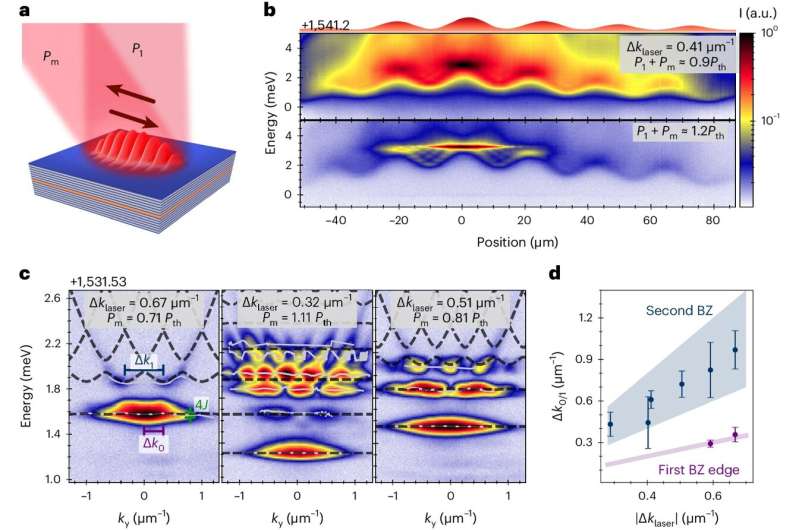This article has been reviewed according to Science X's editorial process and policies. Editors have highlighted the following attributes while ensuring the content's credibility:
fact-checked
peer-reviewed publication
trusted source
proofread
Scientists create an 'optical conveyor belt' for quasiparticles

Using interference between two lasers, a research group led by scientists from RIKEN and NTT Research have created an "optical conveyor belt" that can move polaritons—a type of light-matter hybrid particle—in semiconductor-based microcavities. This work could lead to the development of new devices with applications in areas such as quantum metrology and quantum information.
For the current study, published in Nature Photonics, the scientists used the interference between two lasers to create a dynamic potential energy landscape—imagine a landscape of valleys and hills, in constant repeating motion—for a coherent, laser-like state of polaritons known as a polariton condensate.
They achieved this by introducing a new optical tool—an optical conveyor belt—to enable the control of the energy landscape, concretely, the lattice depths and the interactions between neighboring particles.
By further tuning the frequency difference between the two lasers, the conveyer belt moves at speeds of the order of 0.1% of the speed of light, driving the polaritons into a new state.
Non-reciprocity—a phenomenon where system dynamics are different in opposing directions—is a crucial ingredient for creating what is known as an artificial topological phase of matter. Topology is the mathematical classification of objects by counting the number of number of "holes," e.g., a donut or a knot may have a finite number of holes, while a ball has none.
Quantum materials can also be engineered with a non-zero topology, which in this case is more abstractly embedded into the band structure. Such materials can exhibit behavior such as dissipationless transport, meaning that they can move without energy loss, and other exotic quantum phenomena.
It is extremely challenging to introduce non-reciprocity into engineered optical platforms, and this simple, extendible experimental demonstration opens new opportunities for emerging quantum technologies incorporate functional topology.
The research group, including first author Yago del Valle Inclan Redondo, and led by Senior Research Scientist Michael Fraser, both from RIKEN CEMS and NTT Research, together with collaborators from Germany, Singapore and Australia, have conducted a study in this direction.
Fraser says, "We have created a topological state of light in a semiconductor structure by a mechanism involving rapid modulation of the energy landscape, resulting in the introduction of a synthetic dimension."
A synthetic dimension is a method of mapping a non-spatial dimension, in this case time, into a space-like dimension, such that the system dynamics can evolve in a higher number of dimensions and become better suited to realizing topological matter.
This work extends upon a technique developed by the group, published last year, which similarly used temporally modulated lasers to drive the rapid rotation of polariton condensates.
Using this simple experimental scheme involving the interference between two lasers, the scientists were able to organize polaritons in precisely the right dimensions to create an artificial band structure, meaning that the particles organized into energy bands like electrons in a material.
By tuning the dimensions, depth and speed of the polariton optical lattice, control over the band structure is achieved. Thanks to this rapid motion, the polaritons see a different potential energy landscape depending on whether they are propagating with or against the flow of the lattice, an effect which is analogous to the Doppler shift for sound.
This asymmetric response of the confined polaritons breaks time-reversal symmetry, driving non-reciprocity and the formation of a topological band structure.
"Photonic states with topological properties can be used in advanced opto-electronic devices where topology might greatly improve the performance of optical devices, circuits, and networks, such as by reducing noise and lasing threshold powers, and dissipationless optical waveguiding.
"Further, the simplicity and robustness of our technique opens new opportunities for the development of topological photonic devices with applications in quantum metrology and quantum information," concludes Fraser.
More information: Yago del Valle Inclan Redondo et al, Non-reciprocal band structures in an exciton–polariton Floquet optical lattice, Nature Photonics (2024). DOI: 10.1038/s41566-024-01424-z
Journal information: Nature Photonics
Provided by RIKEN





















